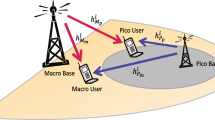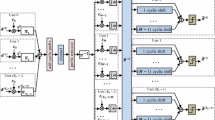Abstract
In order to furnish connectivity to an incredible number of devices and to satisfy the capacity demands, non-orthogonal multiple access (NOMA) is considered as a hopeful solution for future 5G. Moreover, grant-free transmission is substantially expected in the uplink NOMA to minimize the latency time and detection overhead. However, multi-user detection (MUD) without user-activity information in uplink grant-free NOMA is hard in practice. In this paper, by benefit from the user-activity sparsity existing in uplink grant-free NOMA, the multipath matching pursuit (MMP) is used for user-activity detection, and then message passing algorithm (MPA) can be efficiently applied for active users’ data detection. Simulation results show that the proposed MMP-MAP MUD with acceptable complexity can achieve better performance than conventional solutions. Also, the MMP-MAP detector reaches the performance obtained by the MPA detector with perfect user-activity information once the level of signal-to-noise ratio exceed 11 dB.





Similar content being viewed by others
References
Shariatmadari, H., et al. (2015). Machine-type communications: Current status and future perspectives toward 5G systems. IEEE Communications Magazine, 53(9), 10–17.
Bockelmann, C., et al. (2018). Towards massive connectivity support for scalable mMTC communications in 5G networks. IEEE Access, 6, 28969–28992.
Parikh, J., & Basu, A. (2020). Technologies assisting the paradigm shift from 4G to 5G. Wireless Personal Communications, 112, 481–502.
Dai, L., Wang, B., Yuan, Y., Han, S., Chih-Lin, I., & Wang, Z. (2015). Non-orthogonal multiple access for 5G: Solutions, challenges, opportunities, and future research trends. IEEE Communications Magazine, 53(9), 74–81.
Huang, T.-J. (2020). Theoretical analysis of NOMA within massive MIMO systems. Wireless Personal Communications, 112, 777–783.
Dai, X., et al. (2014). Successive interference cancelation amenable multiple access (SAMA) for future wireless communications. In 2014 IEEE International Conference on Communication Systems, IEEE ICCS 2014, 222–226.
Nikopour, H., & Baligh, H. (2013). Sparse code multiple access. In IEEE Annual International Symposium on Personal, Indoor and Mobile Radio Communications, PIMRC, pp. 332–336
Wu, Y., Zhang, S., & Chen, Y. (2015). Iterative multiuser receiver in sparse code multiple access systems. In IEEE International Conference on Communications, vol. 2015-September, pp. 2918–2923.
Wang, B., Wang, K., Lu, Z., Xie, T., & Quan, J. (2015). Comparison study of non-orthogonal multiple access schemes for 5G. In IEEE International Symposium on Broadband Multimedia Systems and Broadcasting BMSB, vol. 2015-August.
Razavi, R., Al-Imari, M., Imran, M. A., Hoshyar, R., & Chen, D. (2012). On receiver design for uplink low density signature OFDM (LDS-OFDM). IEEE Transactions on Communications, 60(11), 3409–3508.
Hong, J. P., Choi, W., & Rao, B. D. (2015). Sparsity controlled random multiple access with compressed sensing. IEEE Transactions on Wireless Communications, 14(2), 998–1010.
Alam, M., & Zhang, Q. (2018). Non-orthogonal multiple access with sequence block compressed sensing multiuser detection for 5G. IEEE Access, 6, 63058–63070.
Abebe, A. T., & Kang, C. G. (2016). Iterative order recursive least square estimation for exploiting frame-wise sparsity in compressive sensing-based MTC. IEEE Communications Letters, 20(5), 1018–1021.
Zhang, Y., Yuan, Z., Guo, Q., Wang, Z., Xi, J., & Li, Y. (2020). Bayesian receiver design for grant-free NOMA with message passing based structured signal estimation. IEEE Transactions on Vehicular Technology, 69(8), 8643–8656.
Wang, B., Dai, L., Mir, T., & Wang, Z. (2016). Joint user activity and data detection based on structured compressive sensing for NOMA. IEEE Communications Letters, 20(7), 1473–1476.
Wang, B., Dai, L., Zhang, Y., Mir, T., & Li, J. (2016). Dynamic compressive sensing-based multi-user detection for uplink grant-free NOMA. IEEE Communications Letters, 20(11), 2320–2323.
Shen, X., Shamaiah, M., & Vikalo, H. (2013). Message passing algorithm for inferring consensus sequence from next-generation sequencing data. In IEEE International Symposium on Information Theory—Proceedings, pp. 1631–1634.
Wang, B., Dai, L., Yuan, Y., & Wang, Z. (2016). Compressive sensing based multi-user detection for uplink grant-free non-orthogonal multiple access. In IEEE 82nd Vehicular Technology Conference (VTC Fall 2015)—Proceeding.
Tan, J., Ding, W., Yang, F., Pan, C., & Song, J. (2016). Compressive sensing based time-frequency joint non-orthogonal multiple access. In IEEE International Symposium on Broadband Multimedia Systems and Broadcasting BMSB, vol. 2016-July, no. 1, pp. 6–9.
Kwon, S., Wang, J., & Shim, B. (2014). Multipath matching pursuit. IEEE Transactions on Information Theory, 60(5), 2986–3001.
Li, H., Wang, J., & Yuan, X. (2018). On the fundamental limit of multipath matching pursuit. IEEE Journal of Selected Topics in Signal Processing, 12(5), 916–927.
Zhao, J., Bai, X., & Tao, R. (2018). Improved RIP-based performance guarantees for multipath matching pursuit. China Information Sciences, 61(10), 1–14.
Author information
Authors and Affiliations
Corresponding author
Additional information
Publisher's Note
Springer Nature remains neutral with regard to jurisdictional claims in published maps and institutional affiliations.
Rights and permissions
About this article
Cite this article
Abed, D., Medjouri, A. CS-Based Near-Optimal MUD for Uplink Grant-Free NOMA. Wireless Pers Commun 118, 3585–3594 (2021). https://doi.org/10.1007/s11277-021-08198-5
Accepted:
Published:
Issue Date:
DOI: https://doi.org/10.1007/s11277-021-08198-5




